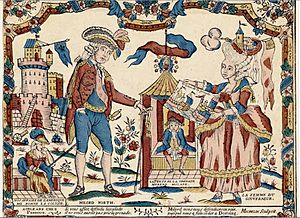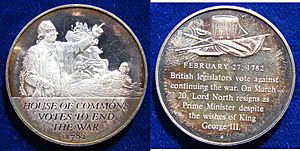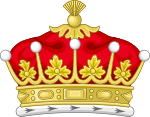Frederick North, Lord North facts for kids
Frederick North, 2nd Earl of Guilford (born April 13, 1732 – died August 5, 1792), was a very important British politician. He is best known as Lord North, a title he used for most of his life. He served as the 12th Prime Minister of Great Britain from 1770 to 1782. During his time as Prime Minister, Great Britain faced the difficult American Revolutionary War, also known as the American War of Independence. Lord North also held other important jobs in the government, like Home Secretary and Chancellor of the Exchequer.
Quick facts for kids
The Earl of Guilford
|
|
|---|---|

Painting by Nathaniel Dance-Holland
|
|
| Prime Minister of Great Britain | |
| In office 28 January 1770 – 27 March 1782 |
|
| Monarch | George III |
| Preceded by | The Duke of Grafton |
| Succeeded by | The Marquess of Rockingham |
| Home Secretary | |
| In office 2 April 1783 – 19 December 1783 |
|
| Prime Minister | The Duke of Portland |
| Preceded by | Thomas Townshend |
| Succeeded by | The Earl Temple |
| Chancellor of the Exchequer | |
| In office 11 September 1767 – 27 March 1782 |
|
| Prime Minister | The Earl of Chatham The Duke of Grafton Himself |
| Preceded by | Charles Townshend |
| Succeeded by | Lord John Cavendish |
| Paymaster of the Forces | |
| In office 21 August 1766 – 9 December 1767 Serving with George Cooke
|
|
| Prime Minister | The Earl of Chatham |
| Preceded by | Charles Townshend |
| Succeeded by | Thomas Townshend |
| Member of Parliament for Banbury |
|
| In office 20 May 1754 – 4 August 1790 |
|
| Preceded by | John Willes |
| Succeeded by | Lord North |
| Personal details | |
| Born | 13 April 1732 Piccadilly, Middlesex, England |
| Died | 5 August 1792 (aged 60) Mayfair, England |
| Resting place | All Saints' Church, Wroxton, England |
| Political party | |
| Spouse | Anne Speke (m. 20 May 1756) |
| Children | 6; including George, Francis and Frederick |
| Parent | Francis North, 1st Earl of Guilford (father) |
| Alma mater | Trinity College, Oxford |
| Signature |  |
Contents
Early Life and Education
Lord North was born in London on April 13, 1732. His family home was Wroxton Abbey in Oxfordshire, where he spent much of his childhood. His father was Francis North, 1st Earl of Guilford. Frederick's mother, Lady Lucy Montagu, died when he was young. His stepmother also passed away when he was thirteen. One of his stepbrothers, William Legge, 2nd Earl of Dartmouth, became a lifelong friend.
North went to Eton College from 1742 to 1748. After that, he studied at Trinity College, Oxford, and earned his Master of Arts degree in 1750. After college, he went on a "Grand Tour" of Europe with his friend Lord Dartmouth. They studied in Leipzig, Germany, and traveled through Austria, Italy, Switzerland, and France before returning to England in 1754.
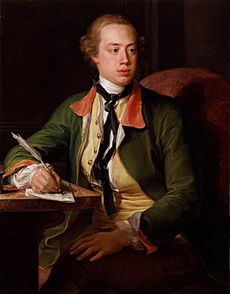
Beginning a Political Career
In 1754, at age twenty-two, Lord North was elected to Parliament for the area of Banbury. He served as a Member of Parliament until 1790. In 1759, he joined the government as a junior Lord of the Treasury. He quickly became known as a good administrator and speaker in Parliament. His colleagues generally liked him.
Even though he first thought of himself as a Whig, he didn't stick closely to any Whig groups. Many people at the time saw him as more aligned with the Tories.
In 1763, he was chosen to speak for the government against a radical Member of Parliament named John Wilkes. Wilkes had written harsh criticisms of the Prime Minister and the King. North successfully pushed for Wilkes to be removed from the House of Commons.
When a new government led by Lord Rockingham took power in 1765, North left his government job. He refused an offer to rejoin, as he didn't want to be part of the Whig leaders who ran that government.
North returned to government in 1766 under William Pitt the Elder. He became a Joint Paymaster of the Forces and a Privy Counsellor. Because Pitt was often ill, the government was mostly run by the Duke of Grafton, with North as a senior member.
Becoming Chancellor of the Exchequer
In December 1767, North became Chancellor of the Exchequer, which is like the head of the country's money department. He also became Leader of the House of Commons in early 1768. He kept these roles when the Duke of Grafton became Prime Minister.
Prime Minister of Great Britain
Lord North became Prime Minister on January 28, 1770, after the Duke of Grafton resigned. His government was often called "Tory," even though it wasn't a formal party. Many of his supporters had been Whigs before. North had a good relationship with King George III. They shared a love for their country and a desire for honest private lives.
Falklands Crisis
Early in his time as Prime Minister, North's government had a success during the Falklands Crisis of 1770 in 1770. Great Britain faced a challenge from Spain, which tried to take over the Falkland Islands. This almost led to a war. Spain's ally, France, decided not to support a war because King Louis XV of France felt his country wasn't ready.
Because Britain showed its strong naval power, France made Spain back down. This event greatly boosted the British government's popularity. It showed that Britain could separate France and Spain and that the Royal Navy was powerful.
American War of Independence
Most of Lord North's time as Prime Minister was focused on the growing problems with the American colonies. These problems led to the American Revolutionary War, which began in 1775. After the Boston Tea Party in 1773, Lord North suggested new laws to punish the people of Boston. These laws were called the Coercive Acts in Britain, but the colonists called them the Intolerable Acts.
North hoped these laws, which shut down the Boston government and stopped trade, would bring peace and discourage the rebellious colonists. Instead, the acts made the colonists even angrier, leading to open war.
Lord North left the overall war strategy to his main helpers, Lord George Germain and the Earl of Sandwich. Even though the British won some battles and captured cities like New York and Philadelphia, they couldn't win the war completely. In 1778, France joined the American rebels. Spain joined France in 1779, and the Dutch Republic joined in 1780. Britain found itself fighting a global war without any allies.
After 1778, Britain focused on defending the West Indies. These islands were very valuable because of their sugar wealth. In 1779, Britain faced a possible invasion by France and Spain, but this plan failed. Several attempts to make peace did not work.
Problems for Britain grew when other countries formed the First League of Armed Neutrality. This group aimed to stop Britain's naval blockades and threatened Britain's supply of naval materials from the Baltic Sea.
Because of a shortage of soldiers, North's government passed a law allowing Catholics to serve in the military. This caused strong anti-Catholic feelings and led to the Gordon Riots in London in June 1780. For about a week, mobs controlled parts of the city until the military stepped in.
Britain's luck in the war in America seemed to improve for a while. However, in October 1781, British forces led by Lord Cornwallis surrendered at the Battle of Yorktown. This was a huge blow to British morale. When Lord North heard the news, he was devastated, reportedly exclaiming, "Oh God! It is all over!"
Resignation from Office
Lord North resigned as Prime Minister on March 20, 1782, because of the British defeat at Yorktown. He was the second British Prime Minister ever to be forced out of office by a "motion of no confidence" (a vote by Parliament that shows they no longer support the leader).
To try and end the war, he had suggested a "Conciliation Plan." He promised that Britain would remove all the unpopular laws if the colonies stopped fighting. However, the colonies rejected this plan because they now wanted full independence.
After North's government fell, Britain's luck in the war actually started to turn around in 1782, thanks to naval victories. These victories were largely due to policies that Lord North and the Earl of Sandwich had put in place. The important British naval victory at the Battle of the Saintes happened after North had already left office.
Fox–North Coalition
In April 1783, Lord North returned to government as Home Secretary. He joined an unusual partnership with a Whig leader named Charles James Fox. This group was called the Fox–North Coalition, led by the Duke of Portland. King George III disliked Fox and never forgave North for working with him.
North never served in government again after this coalition fell apart in December 1783. One of the main achievements of this government was signing the Treaty of Paris, which officially ended the American War of Independence.
The new Prime Minister, William Pitt the Younger, stayed in power for the next twenty years. This meant that both North and Fox were left out of high political office.
Later Life and Legacy
Lord North continued to speak actively in Parliament until he started to lose his eyesight in 1786. On August 4, 1790, he inherited his father's title and became the 2nd Earl of Guilford. He then moved to the House of Lords, the upper house of Parliament. By this time, he was completely blind.
Lord Guilford passed away in Mayfair, England, and was buried at All Saints' Church in Wroxton. His son, George North, took over his father's seat in Parliament for Banbury and later inherited his father's title in 1792.
Today, Lord North is mostly remembered as the Prime Minister "who lost America." Two streets in London, Lord North Street and Guilford Street, are named after him.
Family Life
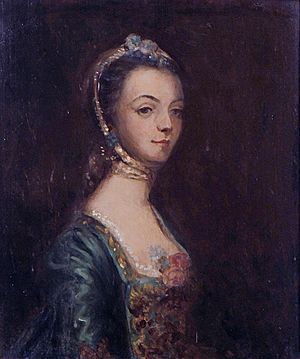
On May 20, 1756, Lord North married Anne Speke. She was the daughter of George Speke, another Member of Parliament. Together, they had seven children:
- George Augustus North, 3rd Earl of Guilford (1757–1802)
- Catherine Anne North (1760–1817)
- Francis North, 4th Earl of Guilford (1761–1817)
- Lady Charlotte North (died 1849)
- Frederick North, 5th Earl of Guilford (1766–1827)
- Lady Anne North (before 1783–1832)
Titles and Styles
- The Honourable Frederick North (1732–1752)
- Lord North (1752–1790)
- The Earl of Guilford (1790–1792)
|
Images for kids
-
In The State Tinkers (1780), James Gillray showed North (on his knees) and his friends as bad repairmen of the "National Kettle." King George III is shown cheering in the back.
See also
 In Spanish: Frederick North, II conde de Guilford para niños
In Spanish: Frederick North, II conde de Guilford para niños


